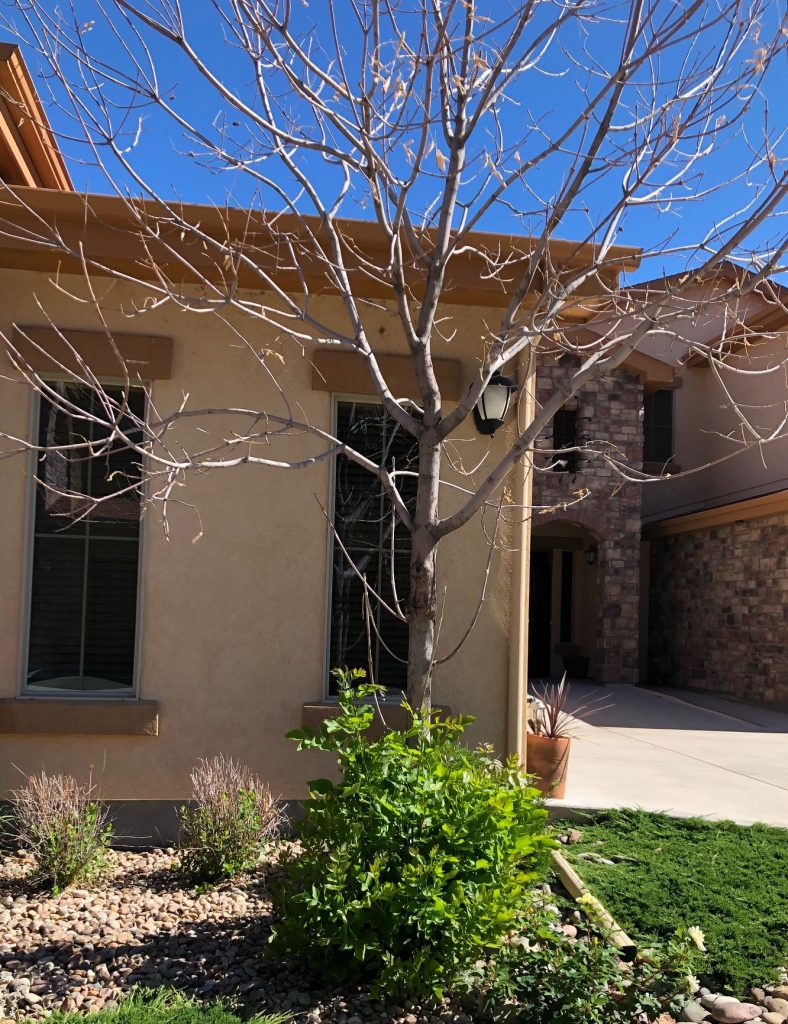My Ash Tree Didn’t Leaf Out!
- 2020-07-09
- By mkirk
- Posted in The Garden Buzz
By Lisa Mason, CSU Extension Horticulture Agent
We have been receiving many calls this summer about trees not leafing out. Are they dead? What do I do? What if my HOA wants me to remove my “dead” tree? Will the tree bounce back?
Colorado is a tough place for trees to grow! In addition to a dry winter, last October and last April we had extreme, sudden temperature changes that impacted many trees. Trees didn’t have a chance to prepare for those weather events, and now we are now seeing the results. Ash trees were significantly impacted. You may notice damage on other trees including catalpa trees, crabapples, some maple trees, and other fruit trees. Conifer trees were also impacted. You may notice new brown needles on your pine and spruce trees or large portions of juniper trees that turned brown.

Recommendations
Healthier trees will likely bounce back, while stressed out trees may not fare as well. However, it is too early to know how trees will do long-term. The best thing to do is wait and see what happens, and keep your tree as healthy as possible. A few tips include:
- Is your tree alive? Even if your tree didn’t leaf out, it may still be alive. You can check the branches. If you scratch the branch, and see green underneath, the tree is still alive. If most of the branches on your tree appear brown underneath the bark, the tree might be dead.
- Provide your tree with supplemental water. Remember that trees need to be watered deeply and infrequently.
- Avoid fertilizing the tree right now. If the tree is significantly stressed, adding fertilizer may add additional stress.
- Avoid extra pruning. You may prune out the dead branches (if you know for sure they are dead), but avoid extra pruning for a while.
- Help the roots stay as healthy as possible. Consider adding mulch around the tree (but keep that first 6-inches from the base of the tree clear). More information here. Mulch will hold in moisture longer. A mulch ring will also avoid mower damage and other activities that could contribute to root compaction. Did you know that tree roots extend up to three times the length of the tree? Read more about Healthy Roots, Healthy Trees.
- Be patient with your tree. Unfortunately, this is a “wait and see” situation. A little patience and a little extra care can go a long way.
What if my HOA asks me to remove my ash tree because it is dead?
Even though ash trees suffered from the recent weather, many of the healthier trees will bounce back. The trees will need a little time to recover. Again, we recommend the “wait and see” approach. Keep in mind that it is only July. Some trees may not leaf out this year, but they might leaf out next year. At CSU Extension, we are happy to provide education to HOAs and homeowners about the status of the ash and other trees from the winter weather.
My ash tree didn’t leaf out, do I have emerald ash borer?
Ash trees have a variety of challenges and stressors besides emerald ash borer, but is important to know and understand the signs of EAB.
Check this guide called Diagnosing Emerald Ash Borer and Other Ash Tree Damage. This guide provides great images on signs of EAB and other common ash tree damage.
Currently, EAB has been confirmed in Boulder, Larimer, Adams and Broomfield counties. It was recently confirmed in Arvada. Read more about making a plan for when emerald ash borer arrives.
Many ash trees in Colorado have lilac ash borer which create round exit holes. Lilac ash borer is a clear-wing moth (not a beetle). Lilac ash borer and other insects of ash trees are usually secondary indicators of stress. They will infest a tree if the tree is already stressed out. Lilac ash borer rarely kills a tree unless the tree is already dying or has recently been transplanted. Treatment is not usually needed. More information on lilac ash borer.
While our ash trees have a lot of challenges now and ahead, in the meantime, let’s be patient with our trees and provide them the best possible care.
Why is my ash tree suckering?
When your ash tree starts suckering, it is called epicormic sprouting or branching. This occurs with ash trees are stressed out. The tree attempts to shoot new growth wherever it can, usually at the base of the tree or on the main branches. Epicormic branching can be caused by a variety of stressors including abiotic (environmental) factors related to weather, drought stress, planting a tree too deep, and other root damage. Due to the winter damage that ash trees sustained this past winter, you could start seeing more epicormic branching.

The shoots growing off the tree will take resources away from the main tree. It is best to remove the new shoots as soon as possible. You can prune them out with clippers. Continue to remove the shoots as they appear. Be careful not to damage the main trunk when removing the shoots.
If you have epicormics branching, we also recommend following best tree care practices previously mentioned in this article.
A tree with EAB can also exhibit epicormic branching, so keep an eye for other EAB signs and symptoms. Since EAB has not been confirmed in the south Denver Metro area, likely the tree is stressed out from weather and other factors.
Horticulture Resources
- Garden Buzz Archives
- CSU Extension Resources
- Colorado Master Gardener Program
- Foothills to Plains Native Plant Master Program
- Native Bee Watch Community Science Program
- The Co-Hort Blog
- PlantTalk Colorado
- Soil Testing
- Plant Select
- Emerald Ash Borer
- Japanese Beetle
- Colorado State Forest Service
- Ask an Expert


